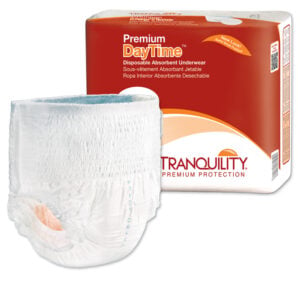The calendar is flipping to summer and temperatures are heating up around the U.S., making it a great time to get out, get moving and enjoy some fresh air. Or maybe you’re just looking to add a little more activity into your life, no matter what time of year it is.
Regardless of your motivation, if you want to increase your activity but have been hesitant to exercise more due to incontinence, read on for low-impact ways to improve your health and well-being. You will also learn about special absorbent products that can keep you protected and discreet, every step, pedal or stroke of the way.
Note: Whether you experience light urinary incontinence while coughing or have more severe incontinence involving loss of bowel control, if you desire and are physically able to exercise more regularly, you should talk with your doctor about a plan that is right for you. This article offers several suggestions for exercises and activities, but please make sure to confirm with your physician before starting any new workout.
Getting back in the pool
Common exercises such as crunches or leg raises may require you to clench your abdominal muscles, which can increase your chance of an accident. Instead of these activities, if you experience loss of bladder or bowel control, you might consider adding water aerobics, aqua-therapy, or other swimming activities into your exercise routine.
Swimming is an excellent way to get a full-body workout without putting unnecessary strain on the pelvic region. Most swimming strokes naturally lift your chest, lengthen your spine, and do not force you to bear down, so they can help you avoid movements that can trigger leaks. Because water is much more resistive than air, you activate your muscles with every movement, making water exercises extremely efficient. Water also provides natural buoyancy, supporting a portion of your body weight to allow slow, smooth movements and avoid joint strain. Plus – after a good swimming workout, you can reward yourself with a relaxing float in the water!
If the idea of getting
- Worn subtly under a bathing suit by men or women, for discreet bowel incontinence protection
- Kufguards® (inner leg cuffs) help contain bowel incontinence, giving extra security that the pool and your bathing suit will stay clean
- Not made from normal absorbent materials found in typical incontinence care products, so they have minimal swelling and will not break apart in water
- Disposable, so there is no need to clean your swimsuit after an episode.
- Tear-away side seams make disposal easy. No more struggling to remove a wet garment!
- Available in adult sizes Medium (waist size 34″-48″ and 120 – 175 lbs) to 2X-Large (62″-80″ and 250+ lbs)
Swimmates are ideal for
Tranquility offers these products in a “Small/Youth XL” size for waist measurements of 22” – 36” and a weight of 80 – 125 lbs. Swimmates may even be covered under state waivers or other programs for children with complex healthcare needs!
Learn more about Swimmates or request a FREE sample pack today!
Other low-impact exercise ideas
Besides swimming, other activities are ideal for those with incontinence, such as using an elliptical device, doing Kegel exercises or just taking a pleasant stroll. Higher-impact activities like weight training and core strength-building can be modified slightly to reduce the risk of an accident, and even cycling can be fun and healthy if a few precautions are taken.
Elliptical machine
Also called a cross-trainer, it’s a lower-impact version of a treadmill. Instead of walking or running atop a moving belt, your feet stay connected to two platforms while moving in a smooth, elongated circular pattern. Some elliptical machines have arm handles so you can also work out your shoulders, chest, and back.
Kegel Exercises
Your doctor may have instructed you on these popular pelvic-floor strengtheners to help manage stress incontinence. If not, the National Association for Continence offers this great Kegel exercise video to get you started.
Walking
Want to start out a bit slower? Walking is a simple activity that is free, does not require a gym membership, and can be done with friends or by yourself. Ask about organized walking programs at your local library, community center, hospital, or your place of work, and you could receive a free or low-cost pedometer or other step-counting device to easily track your progress.
Modified Activities
Mild- to higher-impact exercises, such as lifting weights, can be modified to reduce stress on your core and mid-section to lower the risk of an accident. This is especially important if you experience incontinence that is related to pelvic floor weakness.
To make weight training safer, lighten your weights so that you are not bearing down or grunting; remember to breathe in and out slowly throughout the movements; and when possible, lift from a seated position versus standing or bending over.
Core strength exercises can also be modified. While planking, instead of stretching your legs out, try balancing on your knees. Do push-ups against a wall rather than the ground. Bridge exercises are great for strengthening pelvic floor muscles – follow these steps:
- Lie down with your back flat against the ground and your knees bent at 90 degrees.
- Put your feet flat on the floor and your arms at your side, with palms down.
- Using your heels to push upwards, raise your hips while squeezing your glutes, pelvic floor muscles, and hamstrings.
- Hold for a few seconds, then return to the starting position.
Cycling
You may think that riding a bike, whether taking a spin on a local trail or trying out an indoor spin class, would be rough on the pelvic floor area – and it can be. While a review of a 2021 study found no direct correlation between cycling and urinary incontinence, it also stated that “research on pelvic health and cycling continues to be a work in progress.”
Ways to relieve stress on the mid-section when biking include installing seat-post shock absorbers; elevating the handlebars; alternating standing and sitting while riding; and having a pro shop fit your bike to ensure an ergonomic setup. For stationary cycling, a recumbent bike places the rider in a laid-back, reclining position, which re-distributes body weight more comfortably over a larger area. Also keep in mind that a sudden change in position, such as quickly getting off a bike seat after a long ride, may trigger an episode of leakage – especially if you have urge incontinence – so take it easy when dismounting.
Warm-up
Finally, no matter what workout you have planned, don’t forget to spend a few minutes warming up your muscles and joints beforehand and save a few minutes afterward for a cool-down session with some light stretching. This will not only leave you feeling less sore the next morning but will also gradually help increase your flexibility.
The right absorbent product keeps you moving
Looking for comfortable protection from leaks while you work out? Tranquility® DayTime™ Underwear let you live to the fullest in all-day confidence provided by quiet, form-fitting materials that move with you for leak-free security.
Premium DayTime Underwear provide enhanced discretion with a slimmer profile. Unique Kufguards® leg cuffs guide urine to the superabsorbent core, which holds and locks in fluid, so it will not be squeezed out during movement. The breathable sides help protect your skin by allowing heat and moisture to escape and air to flow in and out. The clothlike material is gentle against your skin and quiet when you move, with a moisture-proof backing that ensures fluid will not leak through. Soft leg elastics combine with a full-rise elastic waistband to create a secure fit. When it’s time for a break, just pull off like regular underwear, or if needed, use the tear-away side seams for easy removal.
If you prefer a tape-tab brief style of absorbent product, Tranquility SlimLine® Briefs will keep you moving confidently, with re-adjustable fasteners, a contoured fit, extended-coverage core, and soft leg elastics providing security against leaks.
Try a free 
About Tranquility
For more than 30 years, Tranquility® brand products have supported individuals in managing their most challenging incontinence care needs, providing a calm and confident space to live well. We offer a variety of styles, in a wide range of sizes from Youth to 5XL, and in three protection levels. Tranquility offers two-pack samples for most of their products, so you have the chance to experience maximum incontinence protection before committing to one item. Just answer a few quick questions on this form to request your free sample. If you have questions about which products are right for you, contact our dedicated Customer Care Center at 1-866-865-6101, Monday-Friday 8 a.m. to 5 p.m. ET or email CustomerService@pbenet.com, anytime.
Sources
- https://www.wmhp.com.au/blogs/weak-pelvic-floor-10-safe-exercises
- https://www.everydayhealth.com/urinary-incontinence-photos/living-well-with-urinary-incontinence.aspx
- https://www.strengthtrainingrehab.com/12-aquatic-therapy-benefits-might-surprise/
- https://nafc.org/exercise-and-lifestyle-tips-for-incontinence/
- https://www.utphysicians.com/three-exercises-to-strengthen-your-pelvic-floor/
- https://www.pedalpt.com/urinary-incontinence-in-cyclists/
- https://www.mendcolorado.com/physical-therapy-blog/2021/7/31/does-cycling-contribute-to-sexual-and-pelvic-floor-dysfunction-in-mend






